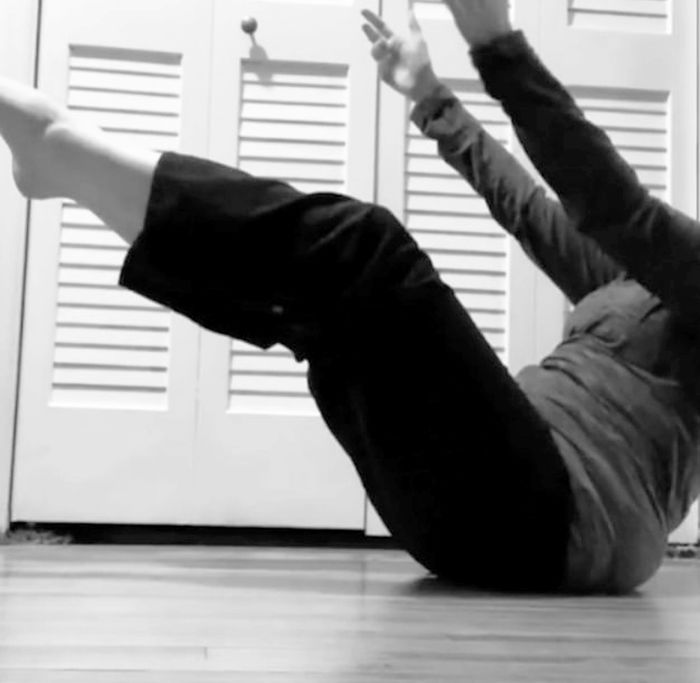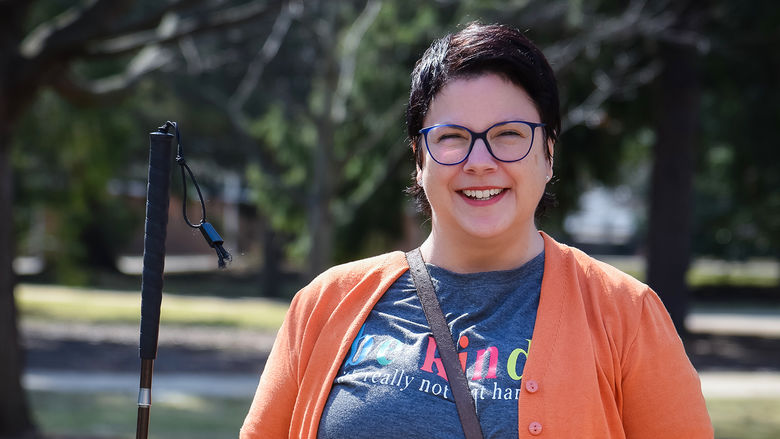

This dialog contains the full navigation menu for this site.

March 2020 came in like a lion—one named COVID-19. Its roar shut down businesses, canceled flights and travel, and closed schools and universities. It canceled movies, sports, concerts, art exhibitions, and theatre, not just around the globe, but on local levels, as well.
Allied Motion Dance Company, comprised of past and current dancers from Penn State Altoona and the public, saw its spring season collapse. Rehearsals were suspended, school programs canceled, and performances put on hold indefinitely.
“We at Allied Motion, like everyone else, felt the impact of the stay-at-home order,” states KT Huckabee, founder of Allied Motion and teaching professor in Penn State Altoona’s Integrative Arts program. “We missed our dance family, working together, dancing together, and creating together.”
“At the time of the COVID shut down, everyone was feeling a bit lost,” adds Caitlin Osborne, former Penn State Altoona dance faculty and managing director of Allied Motion. “We had a huge schedule of performances and events planned from May through September, and their cancellations were a huge blow. In its wake, we asked ourselves how we could maintain our mission.”
Through that mission, building community through the power of movement, Allied Motion collaborates with local composers, musicians, poets, and visual and theatre artists to create a repertory of dances inspired by history, personal experience, fantastical thoughts, and hopes.

A task 1 snapshot of Allied Motion founder KT Huckabee
During the company’s weekly Zoom meetings, ideas for a new project to support the mission began to take shape and, eventually, the Community Choreography Project (CCP) was developed.
The initiative uses social media to gather movement from the public. Ten different movement task lists, consisting of simple movement ideas such as float, jump, and lunge, were posted on Allied Motion’s Facebook page and Instagram account. Community members were encouraged to interpret those words into their movements, then post videos or photos to social media with the hashtag #alliedmotioncommunity. They were also invited to send them to Allied Motion through email or direct message.
Participants included dance studios, friends of Allied Motion, performers and dance enthusiasts, trained and untrained movers, and college professors.
“What is incredible is the range of interpretations we have received,” says Samantha Bacza-Nelson, a Penn State Altoona alumna and member of Allied Motion. “One person limited in her ability interpreted a list by sitting in a chair and moving her hands, fingers, and foot only. Someone created a video of nature, and the way the birds, squirrels, clouds, a stream, and a plant moved was a beautiful interpretation of the movement ideas.”
“It’s a great way to see things from a fresh perspective,” agrees Ana Rossi-Lanzendorfer, Allied Motion member and Community Choreography Project coordinator. “I think we are most excited to see non-dancer interpretations because they are so honest.”
But company members didn’t want to stop with that. Motivated by the project’s momentum and excited to reach further into the community, they used an established event to help spread their mission.

Company member Jamie Apperson executes task 2
The Central Pennsylvania Theatre and Dance Fest showcases the region’s professional and pre-professional theatre, dance, and performing arts groups through one immersive weekend each summer. The Fest offers performances from local and national artists in classical ballet, modern ballet, jazz, tap, hip hop, and even belly dance.
Amid the pandemic, the fest went virtual June 19-21. Allied Motion has participated in the festival since its inception in 2018 and felt the videos they were collecting for the CCP would be a great addition to this year’s online platform.
A five-minute recording of the movement videos along with Allied Motion member comments were shown morning and evening for each of the three days of the festival. On Sunday, a 30-minute documentary, "Creating Community and Choreography in the Virtual Moment," was presented as Allied Motion’s “performance.”
Bacza-Nelson and Osborne created the documentary which gives an inside view of the company’s process and how the CCP was envisioned and executed.
“It was a lot of fun,” says Osborne. “I’ve been doing more video work over the last few years, and I love the challenge of the medium. Sam did a lot of the early editing, and it was amazing to work with her in a new way. We certainly learned a lot!”
“The virtual dance fest perfectly aligned with the virtual basis for our project,” says Bacza-Nelson. “It gave us another opportunity to show people what we were doing during quarantine, show some video submissions, and encourage more people to participate.”

Tom Liszka, Penn State Altoona associate professor emeritus, interprets twirling and spinning.

Allied Motion’s choreographer emerita Renita Romansco shows her interpretation of a task.
The company is still collecting videos and photos until members are back in the studio working together in person. The plan then is to take those responses and create a new, full-company work based on member interpretations and perform the piece at the next Allied Motion concert. “We are looking forward to interpreting submissions and moving together again. We plan on incorporating multimedia elements into the performance to help reflect what this time apart may have meant to us, as well as for those in our community,” says Rossi-Lanzendorfer.
One of the ideas is to use found sound recordings as a soundscape for the piece. Another is to use video projection to put the submissions on the stage with the company. Everybody who participates will have choreography credits and get free tickets to the show.
That lion named COVID-19 still has the world gripped in its powerful jaws, but it cannot stop art or the spirit of creativity and community. CCP is combatting the isolation COVID brought to us. Working on a common project is a way for people to be connected.
CCP also questions the concept of what makes a dancer and choreographer. “The idea that dance is only for the special few with the right training or the right body or innate talent is just wrong, and Allied Motion rejects those notions,” says Osborne.
The CCP proves everyone can dance in some way—all of us are creative and we are all capable of creative movement.

Ana Rossi-Lanzendorfer, Allied Motion member and Community Choreography Project coordinator, explores movement.
Finally, CCP challenges and forces us to find new ways to get out of creative ruts. “One way to do that is to set limits, and the COVID crisis has done that in a big way. So, are we going to whine and complain, or are we going to use the new limits to break out of patterns and find new creativity?” asks Osborne.
Well? Which will you choose?


